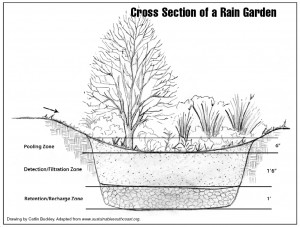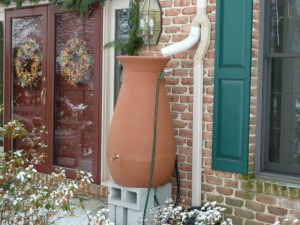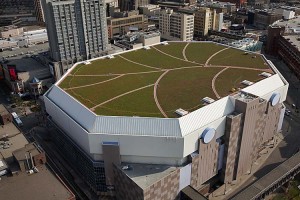A Typical city block will create five times more water runoff than a similar sized forested area. Why should you care? What’s the big deal?
Where should I start?
Runoff will pick up and transfer:
• Soil particles that clog streams and reduce oxygen
• Nutrients
• Heat
• Oil
• Bacteria
• Grease
• Trash
• Fertilizers
• Pesticides
• Animal waste
• Road salt
…and other chemicals and pollutants that all can negatively affect the receiving water and aquatic ecosystems.
There are things that can be done to reduce the amount of water running off an individual property. You will never be able to collect all of it unless you live in a pond. The idea is the more of us that do it, the better for everyone and everything around us.
One of the biggest contributors to runoff is the amount of paved surfaces we have on our properties. That little fact I gave at the beginning of this subject perfectly illustrates this idea. Logically we should start there.
Limit or reduce the size of hard and paved surfaces when possible.
It could be something like adding a vegetative strip in the middle of the driveway. Since the only thing that touches the ground is a car’s tires, why not put grass, groundcover, or mulch in that unused space? There are a variety of permeable paving systems available now that are both aesthetically pleasing and very functional at allowing water to soak into the ground.

Replacing impervious paving with gravel, paving stones, cobble, mulch, and wooden decking where appropriate will be just as functional and do wonders to reducing runoff while adding positive landscape value. Not everything has to be concrete pavement. In fact, adding permeable surfaces will often enhance a property’s visual appeal.
Another thought (while we are on the subject of paving surfaces) is to replace the pavement at the bottom of your driveway with a French drain or grate. Lining impermeable surfaces with gravel trenches may also be effective. It’s okay to think outside the box. My career as a designer relies heavily on it!
Let landscape and nature to do the dirty work.
An exciting trend in the landscaping world today is the use of the rain garden. This effective feature can be a beautiful addition to any property. Essentially it is a shallow concave garden that prevents water runoff by allowing storm water to slowly soak into the ground, permitting impurities to settle out in as little as a few hours.

Rain gardens can be placed at the bottom of a slope, by an outlet, by driveways, or naturally occurring low spots. It can be where water naturally flows or is directed by other means (which I will explain later). These gardens can prevent erosion and make a natural choice as a buffer to shoreline areas.
To make a rain garden effective, the right kind of soil and plant material need to be in place. These gardens will usually be dry most of the time so plants that can handle both wet and dry conditions must be present. The plant material that possess the ability to tolerate “wet feet” should be placed at the bottom while plants that require less water should go toward the top.
Aside from the above conditions, there are a few more rules that should be followed. A proper rain garden should drain 1” of rain in about four hours. Avoidance of standing water is critical for the prevention of mosquito breeding. Anyone in Minnesota understands what this means!
To prevent other problems, the rain garden should not be placed within 10’ of a house. Avoid septic tanks, buried utilities, and placing near walls. Damage from digging and the fact that water can be a destructive force should be reason enough for understanding the implications.
Making sure the water is flowing in the right direction and at the proper rate is imperative. If the natural flow of water is too fast and not moving where you would like it to, then reducing slope, creating berms, and digging swales are a goody remedy. Berms can be used to slow runoff on a steep slope, and swales can be directed toward a storm drain or rain garden. A swale can be filled with vegetation or even stone to create a dry creek bed. In any case, these manipulations are extremely effective and visually appealing methods.
Native plants, such as shrubs and wildflowers, have larger and hardier root systems than turf. These plants will hold much more water than grass. Not only will they help with runoff problems, they will require much less maintenance! Along with native plants, the planting of trees and the preserving of existing ones will serve you well. The root systems that absorb water over a large area and the canopy that slows rainwater can cut runoff considerably. The addition of compost or mulch to the soil will also prove helpful. Just don’t leave soil exposed! If you can’t or don’t want to insert plant material in a particular area of exposed soil, by all means, cover it with mulch, wood chips, or gravel.
The roof and the rain.
As a general rule:
1” of rainfall on a 1000 square foot roof will yield about 600 gallons of water.
What?!
That is a LOT of water. A lot of FREE water. You COULD connect some drain tile out about five or more feet and connect it to a pop-up emitter. It works great to get the water away from your foundation and we do it all the time. Running that rainwater away from the house to a swale or rain garden is desirable. But what if you could collect SOME of that water and use it? Yup—you can. It is called a rain barrel.

Rain barrels are inexpensive, easy to install, easy to operate and maintain. They come in a number of materials, and a variety of shapes and sizes. The system is essentially a barrel connected to a downspout that collects and stores rainwater. Most have an overflow safeguard which sends excess water away to a secondary collection vessel or downspout when the barrel is full. The barrel is equipped with a spigot or hose for the purpose of watering plants.
Now there is a “but” to this seemingly miracle device. Since a roof may contain bacteria and other disease causing organisms from bird and other animal waste, the water collected should NOT be consumed or used on edible plants such as garden vegetables. In fact, the barrel should probably be emptied and rinsed out every so often. If algae begins to grow in the barrel, one tablespoon of household bleach will stop the growth and not hurt landscape plants.
A couple of other things to remember– if you choose to acquire a rain barrel it is advisable to keep the lid of the barrel tightly sealed to prevent mosquitos from breeding and to prevent access by animals and children. The barrel should also be emptied and disconnected in preparation for winter to prevent freezing and cracking.
Now I would be remiss if I didn’t include the green roof in the conversation. For the typical homeowner, this is not really a viable option considering its unique nature. A green roof is a roof that usually contains a liner, insulation, drainage system, planting medium, and drought tolerant, low maintenance plants. As you can see, this is more of an option in a downtown, urban setting where open space is a commodity. They are perfect for high-rise buildings, where they shine in runoff management, lowering temperatures associated with urban heat islands, and improving air quality.

Final thoughts:
Being a lawn and landscape company, we at Barrett Lawn Care AREN’T going to tell you NOT to install an irrigation system in your lawn and plant beds. We, in fact, highly recommend that you DO for a number of important reasons. The aesthetics and health of your lawn depend on frequent watering. However, responsibility must be taken. Our irrigation department will make sure that your yard gets the water it needs only when necessary by installing a weather-based sensor automatic system. These sensor systems take into account a number of different factors including: recent rain events, relative humidity, temperature, and time of day. We will make sure the water gets where it needs to and not on the driveway or other paved surfaces.
As a landscape designer, the topic of water runoff opens up a lot of opportunity for creativity. No two properties are exactly the same in respect to runoff conditions and taste of the homeowner. I take great pride in being able to walk that line and finding unique solutions within those bounds. The next time some rain passes through your neck-of-the-woods, take note of how your yard handles that water. I am sure you (like most of us) are going to notice some room for improvement!
http://www.wikihow.com/Reduce-Stormwater-Runoff-at-Your-Home
http://www.nesc.wvu.edu/pdf/ww/publications/pipline/PL_WI10.pdf
http://www.energyinnovationcorridor.com/page/showcase/target-center-vegetated-roof/
http://www.belgard.com/products/pavers/eco_dublin
http://www.wvwa.org/education/Sustainable-Gardening-Techniques/Rain-Barrels/134/


